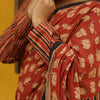7 Best Epochs Shaping Traditional Indian Drapes
- by Divyesh Patel
Embark on a fascinating journey to discover the 7 key epochs that have influenced traditional Indian drapes. From the architectural wonders of the Indus Valley Civilization to the opulent designs of the Mughal Empire, each era has left its mark. The British Colonial Era brought changes to garment tailoring, while the Independence Movement saw a resurgence of cultural identity through clothing. Globalization and modernization blended tradition with modern aesthetics, leading to a sustainable shift in material and design choices. Explore the contemporary revival movements shaping the future of Indian drapes. Dive deeper into the rich tapestry of Indian textile history.
Indus Valley Civilization
Exploring the Indus Valley Civilization reveals a rich tapestry of cultural practices and textile traditions that have endured the test of time. The architectural marvels of this ancient civilization, such as the well-planned cities of Mohenjo-Daro and Harappa, showcase a sophisticated understanding of urban planning. The city layout, with its organized streets, advanced drainage systems, and efficient water supply, highlights the meticulous attention to detail that the Indus people possessed.

Moreover, the Indus Valley Civilization was known for its advanced metallurgy techniques, evident in the artifacts uncovered at various archaeological sites. The mastery of metalworking allowed for the creation of intricate jewelry, tools, and decorative items, showcasing the artistic prowess of the civilization.
Furthermore, the civilization’s strategic location along ancient trade routes facilitated cultural exchange and the influx of various textiles, influencing the indigenous weaving traditions. The intermingling of different cultural influences through trade routes enriched the textile traditions of the Indus Valley Civilization, laying the foundation for the diverse and vibrant textile heritage of India today.
Mughal Empire Influence
The Mughal Empire left a lasting impact on Indian drapes through their patronage of royal textiles and intricate embroidery techniques. Royal Mughal textiles often featured luxurious fabrics like silk and velvet adorned with elaborate designs that showcased the empire’s wealth and power. Artisanal embroidery techniques such as zardozi and chikankari flourished under Mughal influence, adding exquisite detail to traditional Indian drapes.
Royal Mughal Textiles
A significant aspect of the traditional Indian drapes is the intricate influence of Royal Mughal textiles, characterized by opulent designs and rich craftsmanship. Mughal textile craftsmanship is renowned for its intricate weaving techniques and luxurious materials. During the Mughal Empire, regal fabric designs were favored by the royal courts, leading to the development of exquisite textiles that continue to inspire Indian fashion today.

The Mughals were known for their love of intricate patterns, vibrant colors, and detailed motifs, which were reflected in the textiles of the time. Fabrics like fine silks, brocades, and velvets were embellished with elaborate embroidery and embellishments, creating a sense of grandeur and elegance.
Royal Mughal textiles often featured floral motifs, geometric patterns, and intricate borders that added a touch of sophistication to traditional Indian drapes. The use of gold and silver threads in weaving further elevated these fabrics to symbolize wealth and status. Today, the legacy of Mughal textiles lives on in the rich tapestry of Indian fashion, blending history with contemporary style.
Artisanal Embroidery Techniques
Incorporating artisanal embroidery techniques influenced by the Mughal Empire, traditional Indian drapes showcase a rich heritage of intricate craftsmanship and cultural significance. The Mughal Empire’s impact on Indian textiles is evident in the meticulous handiwork and attention to detail seen in traditional craftsmanship. Embroidery techniques such as zardozi, aari, and gota work have been passed down through generations, evolving over time while staying true to their roots. These techniques not only serve as a means of cultural preservation but also pave the way for artistic innovation within the realm of Indian drapes.

The fusion of traditional craftsmanship with evolving techniques highlights the dynamic nature of Indian textiles, where the past informs the present to create a tapestry of timeless beauty. Artisans adept at these intricate embroidery methods infuse each drape with a story, a legacy of skill and artistry that transcends mere fabric. By honoring the legacy of the Mughal Empire through these artisanal embroidery techniques, traditional Indian drapes continue to captivate with their blend of cultural heritage and contemporary flair.
British Colonial Era
During the British Colonial Era, traditional Indian drapes underwent significant adaptations influenced by Western fashion trends. Cultural assimilation was a key aspect during this time, with British influence seeping into the fabric of Indian textiles. The British brought with them a demand for more practical and structured clothing styles, which led to changes in the way traditional Indian garments were draped and tailored.
Textile production also faced a Colonial impact, with an increased focus on efficiency and standardization. The British introduced modern machinery and techniques that altered the way fabrics were woven and printed in India. This shift towards mechanization not only changed the pace of production but also influenced the types of textiles being produced to cater to Western tastes.
Independence Movement Impact
The Independence Movement in India saw a resurgence of traditional Indian drapes as a symbol of cultural identity and resistance against colonial influences on clothing styles and textile production. During this pivotal period, Mahatma Gandhi’s legacy played a significant role in shaping the way Indians viewed their attire. Gandhi’s promotion of Khadi, a hand-spun and hand-woven fabric, symbolized self-reliance and cultural assimilation, encouraging Indians to wear indigenous textiles and reject British-made clothing.

Nationalistic fashion became a powerful tool for expressing patriotism and solidarity with the freedom struggle. The simplicity and elegance of traditional Indian drapes like the saree and dhoti were embraced as symbols of defiance against foreign domination. Indigenous textiles, with their rich history and intricate craftsmanship, became a statement of pride and resilience in the face of colonial oppression.
The Independence Movement era not only marked a political awakening but also a sartorial revolution, where clothing became a form of protest and a celebration of India’s rich cultural heritage. Gandhi’s call for Swadeshi and the revival of traditional Indian drapes laid the foundation for a fashion movement deeply rooted in the spirit of independence and national identity.
Globalization and Modernization
You must consider the impact of globalization on traditional Indian drapes, examining how external influences have shaped and transformed these garments. Explore how globalization has influenced the way traditional Indian attire is perceived and worn in modern contexts, reflecting a blending of cultural elements. Analyze how modernization has led to the integration of contemporary elements into traditional drapes, creating a unique fusion of the old and the new.
Impact of Globalization
In the realm of traditional Indian drapes, the impact of globalization can be observed through the integration of modernization techniques and global fashion trends. This fusion of cultures and fashion has led to a transformation in the way traditional Indian garments are perceived and worn. Here are four ways globalization has influenced traditional Indian drapes:
- Incorporation of Western Elements: Western fashion trends have been seamlessly woven into traditional Indian drapes, creating a unique blend of styles that appeal to a global audience.
- Introduction of Sustainable Practices: Globalization has brought awareness to sustainable fashion practices, leading to the adoption of eco-friendly materials and production methods in the creation of traditional Indian attire.
- Expansion of Design Possibilities: The exposure to diverse design aesthetics from around the world has expanded the creative possibilities for traditional Indian drapes, resulting in innovative and contemporary designs.
- Accessibility and Reach: Globalization has made traditional Indian drapes more accessible to a wider audience through online platforms and international fashion events, increasing their visibility on a global scale.
Influence on Tradition
Globalization and modernization have significantly reshaped the traditional Indian drapes, infusing them with contemporary elements and redefining their cultural significance. The influence of globalization has led to a cultural evolution in traditional Indian drapes, blending age-old techniques with modern aesthetics to cater to diverse preferences and changing lifestyles. This fusion of tradition and modernity has not only expanded the appeal of Indian drapes on a global scale but has also preserved their historical significance by adapting them to current trends.

The traditional drapes have undergone a metamorphosis, adapting to the demands of a rapidly changing world while staying rooted in their rich cultural heritage. The incorporation of modern elements has breathed new life into traditional Indian drapes, making them versatile and appealing to a wider audience. This blending of tradition with contemporary influences showcases the adaptability and timelessness of Indian drapes, ensuring that they remain relevant and cherished in the ever-evolving landscape of fashion.
Modern Elements Integrated
Modern design elements have been seamlessly integrated into traditional Indian drapes, creating a harmonious blend of heritage and contemporary aesthetics. This fusion of traditional craftsmanship with innovative designs has resulted in stunning garments that carry the essence of Indian culture while appealing to modern tastes. Here are four key ways in which modern elements have been integrated into traditional Indian drapes:
- Contemporary Fabrics: Traditional drapes are now being crafted from modern materials such as georgette, chiffon, and organza, adding a touch of luxury and sophistication.
- Innovative Silhouettes: Designers are reimagining traditional silhouettes by introducing asymmetrical cuts, structured drapes, and unconventional hemlines, giving a fresh twist to classic styles.
- Modern Embellishments: Traditional Indian drapes are now adorned with contemporary embellishments like sequins, beads, and metallic accents, adding a touch of glamour and modernity.
- Global Influences: Designers are drawing inspiration from global fashion trends to create fusion styles that blend traditional Indian drapes with Western elements, resulting in unique and eclectic pieces that cater to a diverse audience.
Sustainability and Ethical Fashion
Amid growing awareness of environmental impact and social responsibility, sustainability and ethical fashion have become paramount considerations in the traditional Indian drapes industry. Eco-friendly initiatives such as using natural dyes and organic fabrics are gaining popularity, reducing the ecological footprint of the production process. Fair trade practices ensure that artisans are paid fairly for their craftsmanship, promoting social justice within the industry.

The shift towards sustainable materials like organic cotton, handloom fabrics, and bamboo silk reflects a commitment to reducing waste and promoting longevity in traditional Indian attire. Ethical sourcing practices guarantee transparency in the supply chain, ensuring that materials are sourced responsibly and workers are treated ethically.
Contemporary Revival Movements
As the traditional Indian drapes industry navigates the realm of sustainability and ethical fashion, a resurgence of contemporary revival movements is shaping the future of this cultural heritage. In this era of change and evolution, the following trends are influencing the landscape:
- Cultural Appropriation Awareness: Designers and consumers are increasingly conscious of the importance of respecting the origins of traditional Indian drapes and avoiding cultural appropriation.
- Ethical Production Practices: There is a growing emphasis on ensuring that the production processes of traditional Indian drapes are ethical, fair, and transparent.
- Contemporary Adaptation: Designers are creatively adapting traditional Indian drapes to suit modern tastes and lifestyles, bridging the gap between tradition and innovation.
- Sustainable Practices: The integration of sustainable materials, techniques, and practices is becoming more prevalent in the production of traditional Indian drapes, aligning with the global shift towards eco-conscious fashion choices.
Frequently Asked Questions
How Did Climate and Geography Influence Traditional Indian Drapes?
Climate and geography significantly shaped traditional Indian drapes. Cultural influences and climate impact dictated the choice of fabrics and styles. Geographical variations influenced the design and functionality of these iconic traditional garments, reflecting India’s diverse landscape.
What Materials Were Commonly Used in Traditional Indian Garments?
In traditional Indian garments, silk brocade and cotton muslin were commonly used. Did you know that silk brocade was so intricate that it could take up to 6 months to weave just one yard?
Were There Any Gender-Specific Drapes in Traditional Indian Clothing?
In traditional Indian clothing, there were distinct gender-specific drapes influenced by historical customs and societal norms. These unique drapes not only reflected cultural values but also played a significant role in defining and maintaining gender identities.
How Did Trade Routes Affect the Evolution of Indian Drapes?
Like a river shaping the land, trade routes such as the Silk Road impacted Indian drapes by fostering cultural exchange and spurring textile development. The interconnectedness brought new fabrics, techniques, and styles to Indian clothing.
What Role Did Religion Play in Shaping Traditional Indian Drapes?
Religious influence deeply impacted the evolution of traditional Indian drapes, infusing them with cultural symbolism. Various faiths dictated styles, colors, and patterns, weaving spiritual beliefs into everyday attire, showcasing a harmonious blend of religion and fashion.
Conclusion
As you reflect on the rich history of traditional Indian drapes, imagine each epoch as a thread in a vibrant tapestry, weaving together culture, heritage, and innovation. Like a delicate dance of colors and patterns, these influences have shaped the way we perceive and appreciate Indian fashion today. Embrace the beauty and diversity of these epochs, much like a kaleidoscope of traditions coming together to create a timeless masterpiece.





